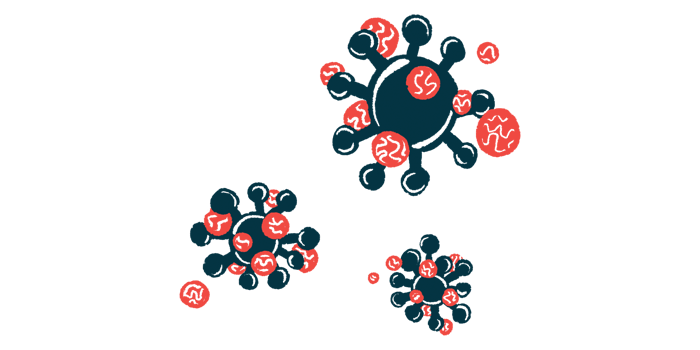EBV dormant in MS reactivates with disease activity, study finds
Blocking EBV activation can reduce inflammatory activity in immune cells

Dormant Epstein-Barr virus (EBV) becomes activated during periods of disease relapse in multiple sclerosis (MS) and triggers inflammatory activity in multiple types of immune cells, a study suggested.
Blocking EBV activation can reduce the inflammatory activity of immune cells, supporting the idea that targeting the dormant virus may be a useful strategy to treat MS, the researchers said.
The study, “Multiple sclerosis patient-derived spontaneous B cells have distinct EBV and host gene expression profiles in active disease,” was published in Nature Microbiology.
EBV is best known as the cause of infectious mononucleosis, though it also commonly causes nonspecific childhood illnesses. The vast majority of humans are infected with EBV by the time they reach adulthood. After the initial infection, the EBV virus stays in B-cells (a type of immune cell) in an inactive or latent state, but in some situations it can switch to an active, or lytic, state, prompting a new round of infection.
Infection with EBV has been identified as one of the strongest risk factors for developing MS. However, the biological details of how EBV and MS are connected remain poorly understood.
Analyzing B-cell lines
The scientists analyzed B-cell lines derived from EBV-infected people, aiming to better understand how the virus affects immune activity. They analyzed samples from MS patients with active disease on MRI scans (that is, with at least one lesion with active inflammation), samples from MS patients with stable disease (without active lesions), and samples from people who did not have MS.
They found that in B-cells from people with active MS, EBV showed more active, lytic activity compared with cells from healthy people or from stable MS patients. The increase in lytic viral activity in B-cells during active MS was accompanied by increases in inflammatory markers in these cells.
B-cells are known to play a major role in driving MS-related inflammation. Several approved MS treatments work by specifically targeting these immune cells. The researchers’ findings implied that reducing EBV lytic activity might also reduce the B-cell-mediated inflammation that drives MS.
As an initial test of this idea, the researchers used their cell models to test three antiviral compounds that can block EBV lytic activity through different biological mechanisms. Results showed two of the compounds — foscarnet and tenofovir alenfenamide (TAF) — reduced markers of B-cell inflammation. However, foscarnet was toxic to the B-cells themselves, whereas TAF was not.
This result “shows that the problematic inflammation signaling from lytic EBV can be selectively targeted in a way that demonstrably reduces damaging immune responses,” Paul M. Lieberman, PhD, director of the Wistar Institute’s Center for Chemical Biology & Translational Medicine and co-author of the study, said in a Wistar press release.
Further experiments demonstrated that, when EBV-infected B-cells were grown alongside T-cells — another type of immune cell with a central role in driving MS — treatment with TAF reduced the inflammatory activity of the T-cells as well.
“Collectively, these data suggest that a population of EBV[-infected] B cells that fail to control EBV latency and consequently drive B and T cell inflammation is expanded during periods of active disease in MS patients,” the scientists wrote, adding that the result “provides support for developing therapies that specifically target EBV-infected … B cells in MS.”
Limitations of the study include the fact that experiments were done in lab models that might not fully reflect the biology of cells in the human body, and the fact that the study included a fairly small number of samples, the team noted.
“We’re excited about expanding this concept further,” Lieberman said. “We have the potential to see whether TAF or other inhibitors of EBV might be a viable treatment for multiple sclerosis that can stop the autoimmune damage without causing wide-ranging and dangerous cell death.”







